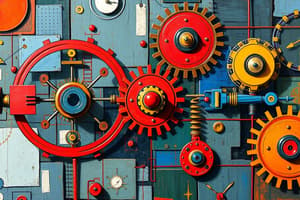Podcast
Questions and Answers
What is the primary purpose of a simple machine?
What is the primary purpose of a simple machine?
- To modify the motion and magnitude of force applied to an object (correct)
- To reduce the amount of energy required to do work
- To replace human effort entirely
- To generate internal force
What is the unit of measurement for energy in physics?
What is the unit of measurement for energy in physics?
- Kilogram (kg)
- Newton (N)
- Meter (m)
- Joule (J) (correct)
How is the amount of energy needed to move an object determined?
How is the amount of energy needed to move an object determined?
- By the force applied to the object times the distance moved (correct)
- By the mass of the object
- By the distance the object is moved
- By the speed of the object
What is the definition of 'work' in physics?
What is the definition of 'work' in physics?
How many types of simple machines are there?
How many types of simple machines are there?
What is the primary function of a screw in construction?
What is the primary function of a screw in construction?
What is the main advantage of using a lever?
What is the main advantage of using a lever?
How does a wheel and axle obtain mechanical advantage?
How does a wheel and axle obtain mechanical advantage?
What is the main advantage of using a pulley system?
What is the main advantage of using a pulley system?
How is the percent efficiency of a simple machine calculated?
How is the percent efficiency of a simple machine calculated?
What is the main purpose of simple machines in doing work?
What is the main purpose of simple machines in doing work?
What is the law of conservation of energy related to simple machines?
What is the law of conservation of energy related to simple machines?
What is the function of a fulcrum in a lever?
What is the function of a fulcrum in a lever?
What is the main difference between an inclined plane and a wedge?
What is the main difference between an inclined plane and a wedge?
What is a screw in the context of simple machines?
What is a screw in the context of simple machines?
Flashcards are hidden until you start studying
Study Notes
Simple Machines
- Simple machines are devices with little or no moving parts that modify the motion and magnitude of force applied to an object to perform work.
- There are six types of simple machines: inclined planes, levers, wheel and axles, pulleys, wedges, and screws.
Understanding the Physics of Simple Machines
- Work is defined as the transfer of energy from one object to another via applied force.
- Work is measured as energy with the unit joules (J), which is equal to one newton (N) of force applied to an object moving one meter (m).
- Energy (J) can be calculated as force (N) times distance (m).
How Simple Machines Work
- Simple machines work by changing the direction of a force, which amplifies the amount of force exerted on the object.
- Simple machines do not add additional energy to the work being done; they add additional force.
- The amount of energy exerted stays the same, as energy cannot be created nor destroyed.
Levers
- A lever is a simple machine that includes a rod, board, or beam, and an edge that the beam balances on, known as a fulcrum.
- The beam is divided into two parts, known as the effort arm and the resistance arm.
- By making the effort arm longer, less force is required to lift the heavier object.
Inclined Planes
- Inclined planes are simple machines that consist of a ramp, or a sloped surface used to raise heavy objects.
- The force needed to push or pull an object up an inclined plane is less than the force it would take to push or pull an object straight up and down.
- Examples of inclined planes include stair ramps, hills, truck ramps, and spiral scaffolding.
Wedges
- A wedge is any object that is wider on one end and tapers to a point.
- A wedge is a double-inclined plane that is used to split things apart.
- Examples of wedges include axes, knives, and the teeth of a saw.
Screws
- A screw is a modified inclined plane combined with a wedge that is wrapped around a cylindrical rod known as the screw's threads.
- The threads are positioned in a spiraling incline that allows the screw to be turned.
- Mechanical advantage is obtained in the same way as an inclined plane, where rotational force and motion are converted into linear force and motion.
Wheel and Axle
- A wheel and axle is made up of a larger circular disk, or wheel, and a thin rod is connected to a disk or axle.
- As the wheel is turned, the axle is also turned.
- Mechanical advantage is obtained by changing both the direction and the distance of the exerted force.
Pulley
- A pulley is a wheel on an axle, but instead of both wheel and axle turning, the axle is stationary and the wheel spins on the axle.
- A rope is then connected to the edge or lip of the wheel and is used to hoist objects.
- Mechanical advantage is achieved by the increase in the distance provided by the rope.
Efficiency of Simple Machines
- The percent efficiency of a simple machine is a measure of the ratio of the work that the machine puts out and the machine that is put into the machine.
- The higher the percent efficiency, the more practical and efficient the machine.
- To find the percent efficiency, the output work is divided by the input work and then multiplied by 100.
Studying That Suits You
Use AI to generate personalized quizzes and flashcards to suit your learning preferences.




